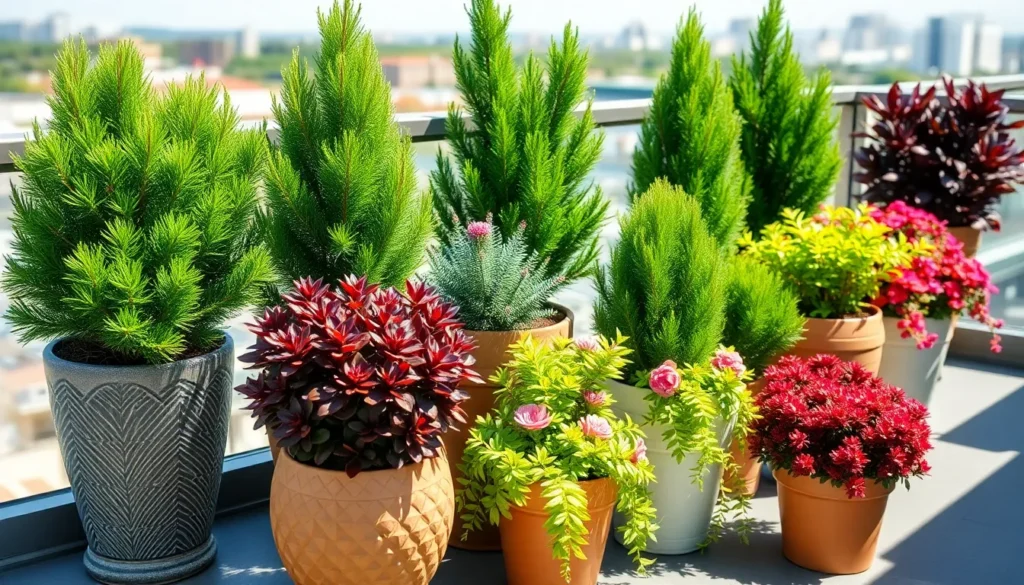We’ve all been there—staring at empty pots and patios wondering how to create year-round beauty without the constant replanting hassle. Evergreen plants for containers offer the perfect solution, delivering stunning foliage and structure that looks amazing through every season.
Whether you’re dealing with a small balcony or a sprawling deck, potted evergreens transform outdoor spaces into lush retreats that never lose their appeal. From compact conifers to glossy-leafed shrubs, these hardy plants thrive in containers while providing the backbone your garden design needs.
We’ll show you the best evergreen varieties that flourish in pots, along with essential care tips that’ll keep them looking spectacular year after year. Get ready to discover low-maintenance plants that deliver maximum impact—your outdoor space is about to become the envy of the neighborhood.
Choose Low-Maintenance Boxwood for Year-Round Structure
Boxwood delivers exceptional structural beauty to container gardens while requiring minimal care throughout the seasons. These versatile evergreens maintain their dense, compact form naturally and adapt well to various pot sizes and growing conditions.
Dwarf English Boxwood Varieties
Buxus sempervirens ‘Suffruticosa’ stands as our top choice for formal container displays. This classic variety grows slowly to 3 feet tall and wide, making it perfect for medium to large pots. We appreciate how it maintains its naturally rounded shape without frequent pruning, saving time and effort throughout the year.
Green Gem boxwood offers exceptional cold hardiness down to zone 4, making it ideal for northern climates. This dwarf variety reaches only 2 feet in height and spreads 3 feet wide, creating an attractive mounded appearance in containers. Its dense foliage provides excellent structure while tolerating both drought and occasional overwatering.
Green Velvet boxwood combines the best traits of English and Korean varieties. We find this hybrid particularly valuable for its disease resistance and ability to maintain deep green color even during harsh winters. It grows to 4 feet tall and 3 feet wide, making it suitable for larger statement containers.
Japanese Boxwood for Compact Spaces
Buxus microphylla var. japonica excels in small containers where space is limited. This species naturally stays compact, reaching only 4 to 6 feet at maturity while maintaining a dense, rounded form. We recommend it for balcony gardens and tight spaces where larger varieties might overwhelm the area.
Winter Gem boxwood delivers outstanding performance in containers exposed to harsh winter conditions. This Japanese variety tolerates temperatures down to zone 4 and maintains its bright green color throughout the coldest months. It reaches 4 feet tall and wide, making it perfect for medium sized pots on patios and decks.
Green Mountain boxwood provides rapid establishment in containers while maintaining manageable size. This Korean Japanese hybrid grows to 5 feet tall with a naturally conical shape that adds vertical interest to container displays. We value its exceptional winter hardiness and resistance to common boxwood diseases.
Select Hardy Juniper Varieties for Dramatic Texture
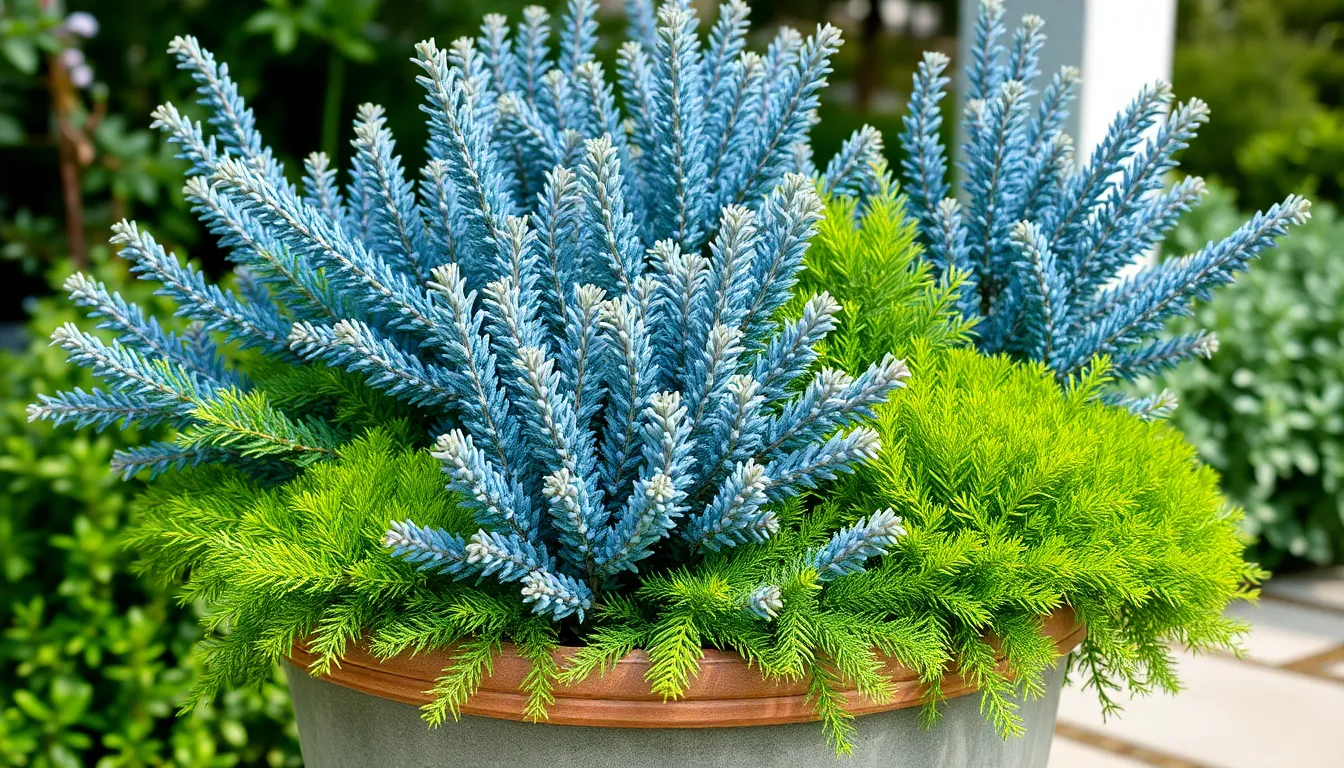
Junipers bring stunning textural contrast to container gardens with their needle-like foliage and diverse growth habits. We’ve identified exceptional varieties that thrive in pots while delivering year-round visual appeal.
Dwarf Blue Juniper Options
Blue Star Juniper transforms containers with its striking silver-blue foliage and compact growth habit. This hardy dwarf variety grows slowly and tolerates drought conditions once established, making it perfect for container specimen displays. Position it in full sun locations with well-draining soil for optimal color development.
Green Mound Juniper creates beautiful cascading effects in hanging containers or elevated planters. Growing only 8 inches tall, this spreading variety works exceptionally well in bonsai containers. Full sun exposure and well-draining soil conditions help this juniper tolerate dry periods effectively.
Both varieties offer exceptional versatility for small space gardening and mixed container arrangements. Their compact size makes them ideal for balcony gardens, while their drought tolerance reduces maintenance requirements significantly.
Upright Juniper Cultivars
Aquavita Juniper delivers stunning vertical interest with its blue-aqua foliage and slender pyramidal shape. This hardy variety works perfectly as a focal point in mixed container borders or screening applications. Many hardiness zones support this cultivar’s growth requirements.
Gin Fizz Juniper provides dense architectural structure with its pyramidal form and rich green foliage complemented by blue berries. Container gardens benefit from this variety’s versatility as both specimen plants and screening elements. Dense branching creates excellent textural contrast against other evergreens.
Tortuga Juniper offers low mounding texture with emerald-green foliage that withstands cold climates exceptionally well. This dwarf variety resists deer damage and tolerates urban air pollution, making it suitable for city container gardens. Drought resistance reduces watering frequency once the plant establishes.
Plant Fragrant Rosemary for Culinary and Ornamental Appeal
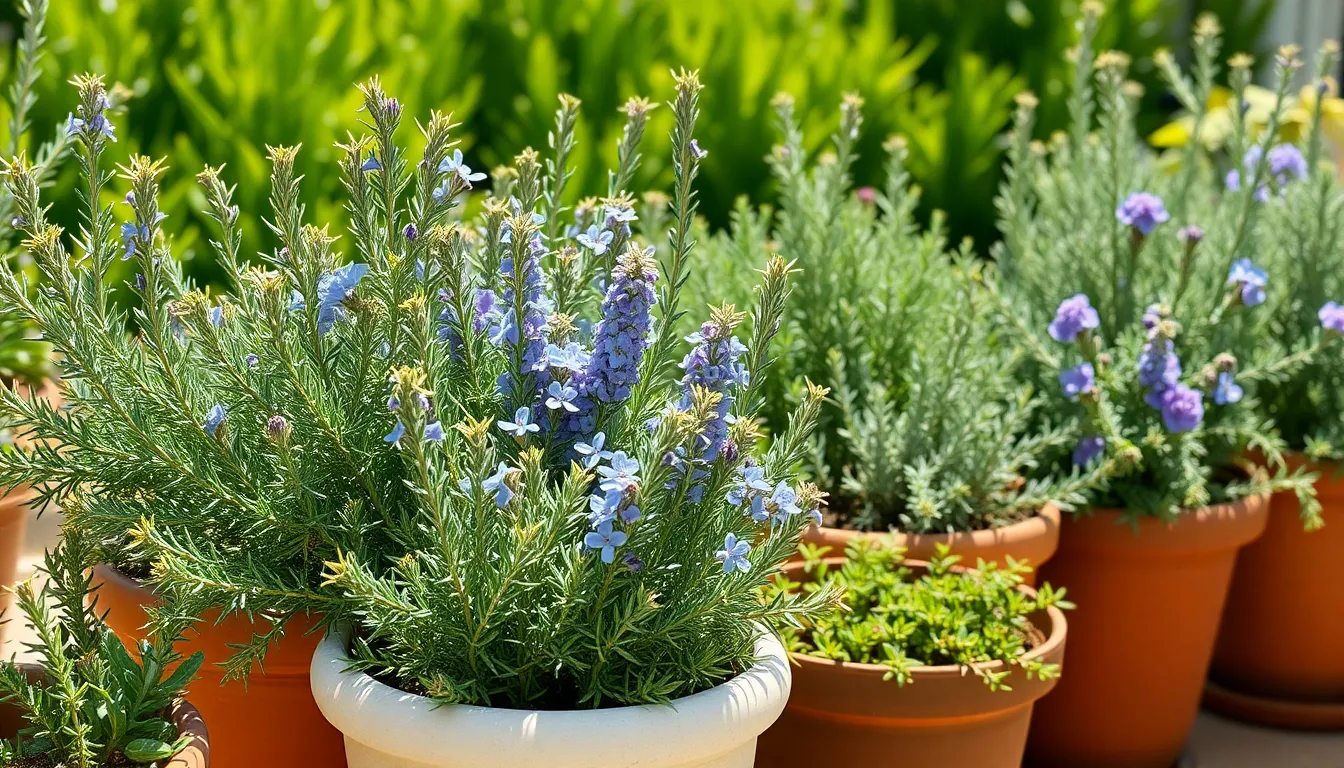
Fragrant rosemary stands out as our top choice for combining culinary herbs with ornamental beauty in container gardens. This aromatic evergreen thrives in full sun and well-drained soil, making it perfectly suited for pot cultivation while adding sensory appeal through its needle-like foliage and delicate blue flowers.
Prostrate Rosemary Varieties
Prostrate rosemary creates stunning trailing displays that cascade beautifully over container edges and hanging baskets. These groundcover varieties grow horizontally rather than vertically, spreading outward to form lush carpets of aromatic foliage without taking up precious vertical space in your garden design.
We recommend these low-growing selections for their ability to soften hard container edges while providing abundant fresh herbs for cooking. Their spreading nature makes them ideal for mixed plantings where you want aromatic texture without overwhelming other plants. Regular harvesting encourages bushier growth and prevents the plants from becoming too woody over time.
Hanging containers showcase prostrate rosemary varieties particularly well, allowing their trailing branches to flow naturally downward. The cascading effect creates visual interest while keeping the fragrant foliage within easy reach for harvesting. These varieties also work excellently in wide, shallow pots where their spreading habit can be fully appreciated.
Upright Rosemary Selections
Upright rosemary varieties bring vertical structure and architectural interest to our container arrangements, growing erect to form compact shrubs that can reach several feet in height. These traditional rosemary types serve as excellent focal points in larger pots or as backdrop plants in mixed container compositions.
We prefer upright selections when creating formal herb gardens or when we need height variation in our container displays. Their sturdy vertical growth habit makes them perfect for topiary work, allowing us to shape them into spheres, cones, or other decorative forms through regular pruning.
Traditional upright rosemary cultivars develop into substantial shrubs over time, providing both ornamental value and abundant harvests for culinary use. Regular pruning maintains their desired shape while encouraging new growth and preventing the plants from becoming leggy. These varieties establish quickly in containers and adapt well to various pot sizes, making them versatile choices for different garden designs.
Container-grown upright rosemary requires consistent watering during growing season, but their drought tolerance makes them forgiving if we occasionally miss a watering. Feeding with weak fertilizer every few weeks during active growth periods keeps these aromatic evergreens healthy and productive throughout the growing season.
Grow Colorful Heather for Seasonal Interest
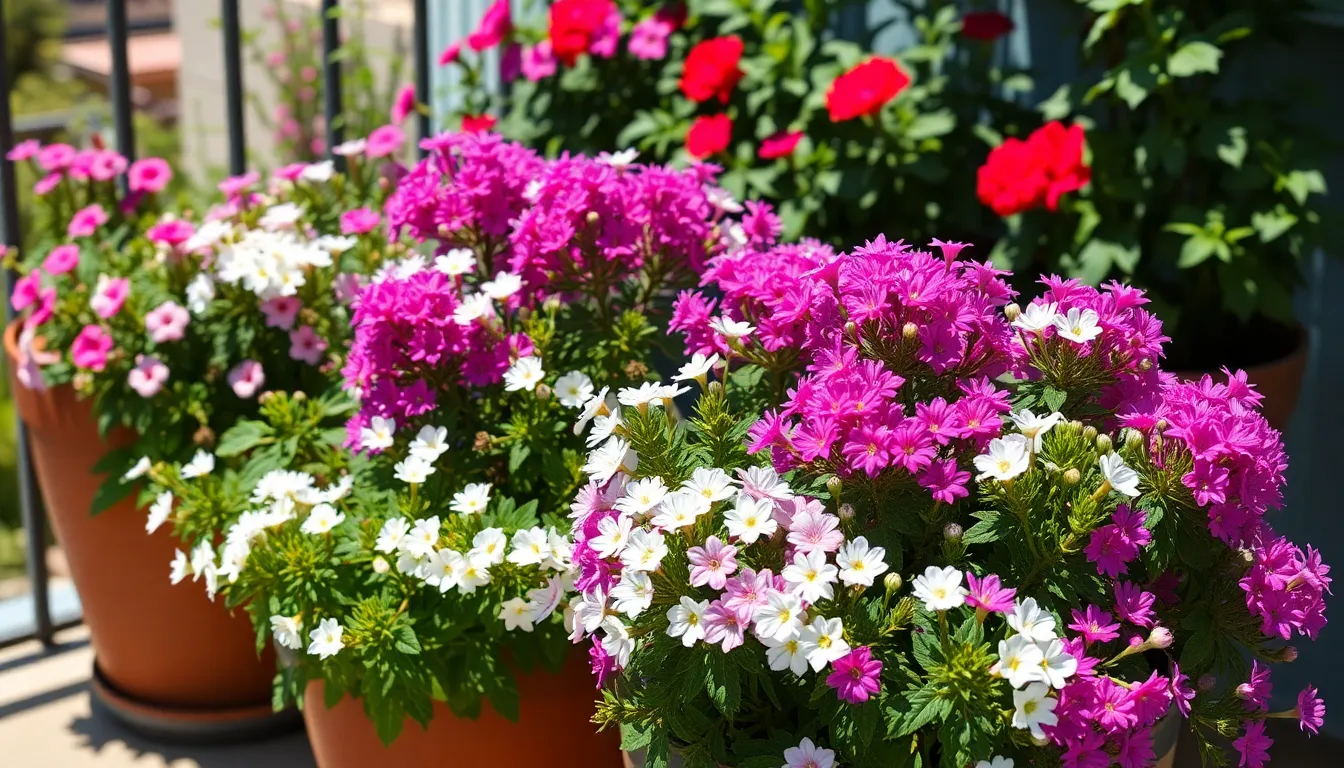
Heather brings exceptional value to container gardens with its vibrant blooms and year-round evergreen foliage. We recommend this versatile plant because it provides consistent color throughout multiple seasons while maintaining attractive structure in pots.
Winter-Blooming Heather Types
Erica species transform cold-season containers with their brilliant winter flowers when most plants remain dormant. These hardy varieties bloom from late winter through early spring, creating stunning displays in sunny locations.
Winter-flowering heather thrives in well-drained, acidic soil conditions typical of ericaceous plants. We’ve found these varieties particularly effective for brightening patios and balconies during the dreary months between December and March.
Popular Erica cultivars include varieties that produce pink, white, or purple bell-shaped flowers. These blooms often last for several months, providing excellent value for container gardeners seeking extended seasonal interest.
Root protection becomes essential for winter-blooming heather in colder climates. We recommend insulating containers or partially burying pots to shield roots from extreme temperature fluctuations that can damage these evergreen beauties.
Summer-Flowering Heather Options
Calluna species deliver spectacular summer color with their dense flower spikes and attractive evergreen foliage. These varieties typically bloom from mid-summer through fall, extending the flowering season well beyond many other container plants.
Long-lasting blooms characterize summer heather varieties, often maintaining their colorful display for 8 to 12 weeks. We appreciate how these plants continue providing visual interest even after flowers fade, thanks to their textured evergreen leaves.
Architectural form makes Calluna species excellent choices for structured container arrangements. These plants naturally develop compact, mounded shapes that complement other evergreens like boxwood, junipers, and rosemary in mixed plantings.
Feeding requirements for summer heather involve regular applications of weak nutrient answers throughout the growing season. We suggest using fertilizers designed for acid-loving plants to maintain healthy growth and abundant flowering in container environments.
Add Elegant Conifers for Vertical Appeal
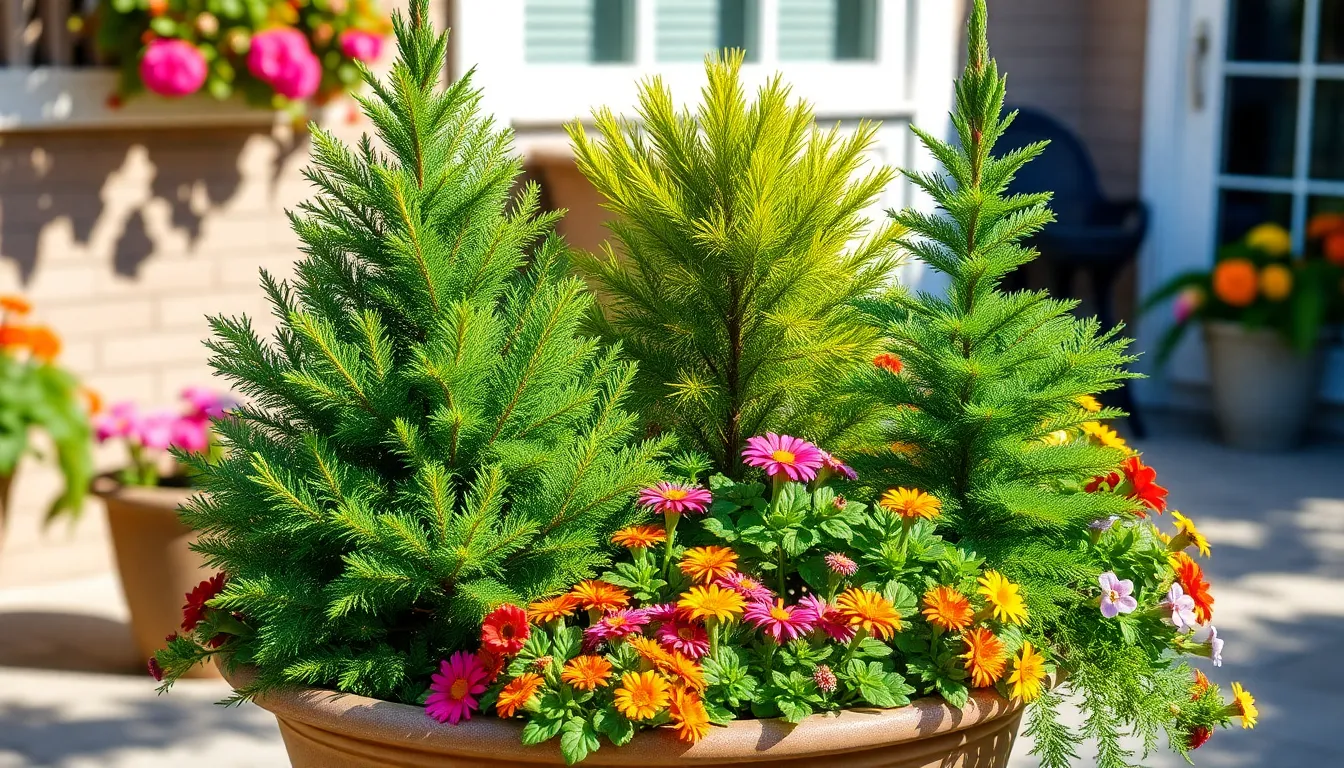
Building on our exploration of evergreen container options, we’re now diving into conifers that create stunning vertical elements in pot displays. These architectural plants transform ordinary container gardens into sophisticated outdoor spaces.
Dwarf Alberta Spruce Characteristics
Dwarf Alberta Spruce (Picea glauca ‘Conica’) stands out as our top recommendation for container gardening due to its perfect combination of slow growth and elegant form. This compact conifer develops a naturally dense, conical shape that reaches up to 10 feet over many years, making it ideal for long-term pot culture. Its bright green needles maintain their vibrant color throughout all seasons, while the uniform growth habit creates a striking architectural element in any container display.
Growth patterns make this spruce particularly suitable for pot gardening since it typically adds only 2-4 inches of height annually. The dense foliage creates a formal appearance that works beautifully in both modern and traditional container arrangements. Winter hardiness allows this spruce to thrive in various climates when provided with proper container protection and consistent watering schedules.
Maintenance requirements remain minimal, though regular watering becomes essential for container specimens. We recommend using well-draining potting soil specifically formulated for conifers to prevent root rot. Light fertilization during the growing season supports healthy development without promoting excessive growth that might compromise the plant’s compact form.
Miniature Pine Tree Varieties
Miniature pine varieties offer diverse textures and colors that create exceptional focal points in container gardens. These compact cultivars display needle colors ranging from deep green to striking blue-gray, providing visual interest throughout the year. Slow growth rates make them perfect candidates for pot culture, as they maintain manageable sizes for extended periods.
Dwarf Mugo Pine represents one of our favorite miniature options for containers due to its naturally rounded growth habit and exceptional cold tolerance. This variety typically reaches 3-5 feet in height and width, creating a dense, mounded appearance that works well as a centerpiece plant. Its dark green needles provide excellent contrast when paired with flowering annuals or trailing perennials in mixed container displays.
Blue-needled pine cultivars add unique color dimensions to evergreen container collections. These varieties offer silvery-blue foliage that creates stunning contrasts against traditional green plants. Their tolerance to pruning and shaping allows for creative topiary work or maintaining exact sizes for particular container requirements.
Pruning flexibility gives miniature pines additional versatility in decorative containers. Regular light pruning helps maintain desired shapes while encouraging denser growth patterns. This adaptability makes them excellent choices for formal container arrangements or more naturalistic plantings where subtle shaping enhances their natural beauty.
Include Broadleaf Evergreens for Lush Foliage
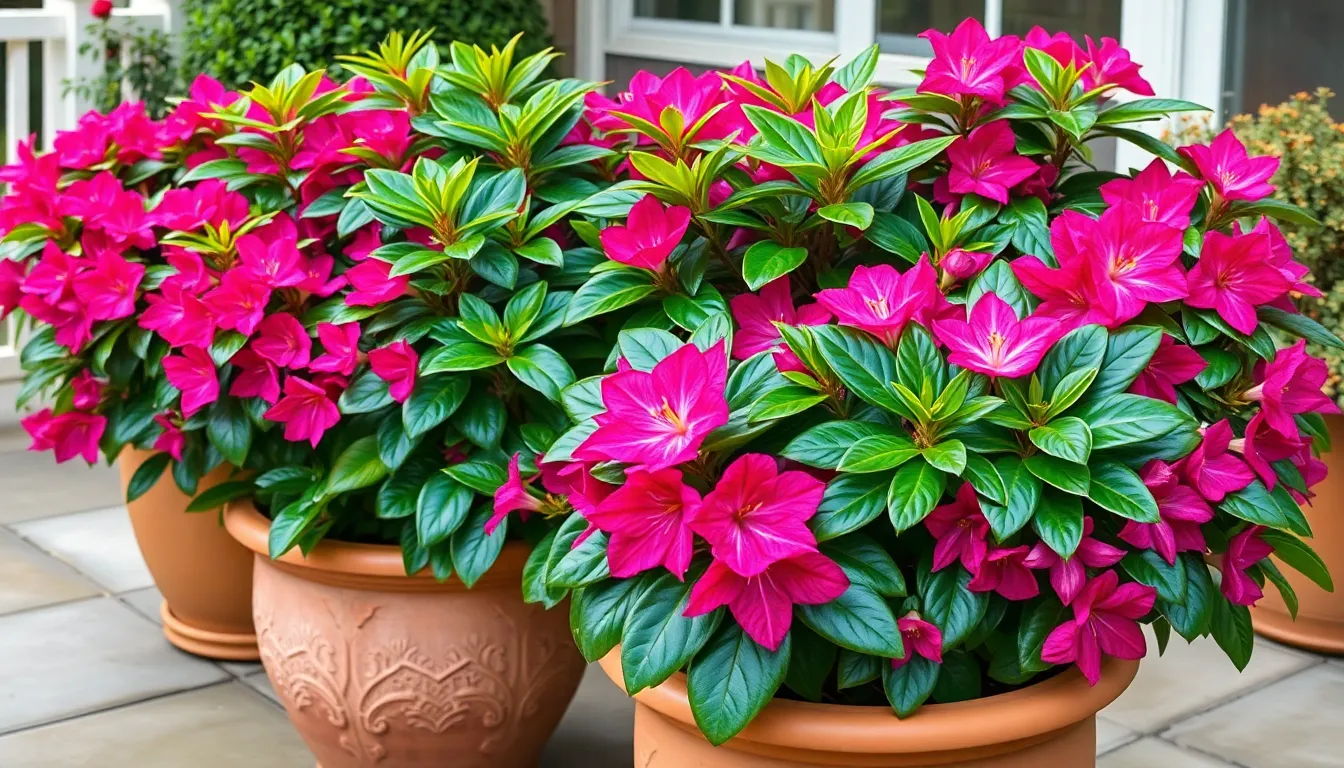
Expanding beyond conifers and needle-bearing options, we’ll explore broadleaf evergreens that bring dense, glossy foliage to container gardens year-round. These plants offer architectural interest with their substantial leaves while maintaining the low-maintenance appeal of evergreen container gardening.
Rhododendron and Azalea Selections
Rhododendrons deliver spectacular spring blooms while maintaining evergreen foliage that provides texture and depth throughout the year. We recommend compact varieties that thrive in acidic, well-drained soil with consistent moisture levels in partial shade conditions. Their dense evergreen leaves create lush backdrops even when flowering season ends, making them excellent foundation plants for container arrangements.
Azaleas complement rhododendrons perfectly since they share similar care requirements and growing conditions. Compact cultivars work best in pots where you can easily control soil acidity and drainage. Their evergreen foliage adds year-round structure while seasonal blooms provide vibrant color displays. We often pair these shrubs together in larger containers to create stunning spring focal points that maintain visual interest through all seasons.
Both plant types prefer sheltered positions where they’re protected from harsh afternoon sun and drying winds. Regular watering keeps their shallow root systems healthy, while acidic potting mixes support optimal growth and bloom production. Their moderate growth habits make them ideal long-term container residents that won’t quickly outgrow their pots.
Camellia Varieties for Containers
Camellias bring elegant sophistication to container gardens with their glossy, dark green leaves and beautiful flowers that bloom during cooler months. We select cultivars specifically bred for container culture that maintain moderate growth habits and adapt well to pot restrictions. Their glossy foliage provides year-round appeal while spectacular blooms range from pure white to deep red colors.
Many camellia varieties excel in partial shade positions where they’re protected from harsh sun and frost damage. Acidic, well-draining soil supports their root health while regular watering prevents stress during growing seasons. We position these containers near entryways and patios where their stunning winter and early spring blooms can be easily appreciated.
Container-grown camellias require consistent moisture without waterlogged conditions that can damage their root systems. Their tolerance of container restrictions makes them perfect for gardeners who want showy evergreen shrubs in smaller spaces. Regular feeding with acid-loving plant fertilizers supports healthy growth and abundant flowering throughout their extended blooming periods.
Choose Cold-Hardy Yew for Shaded Areas
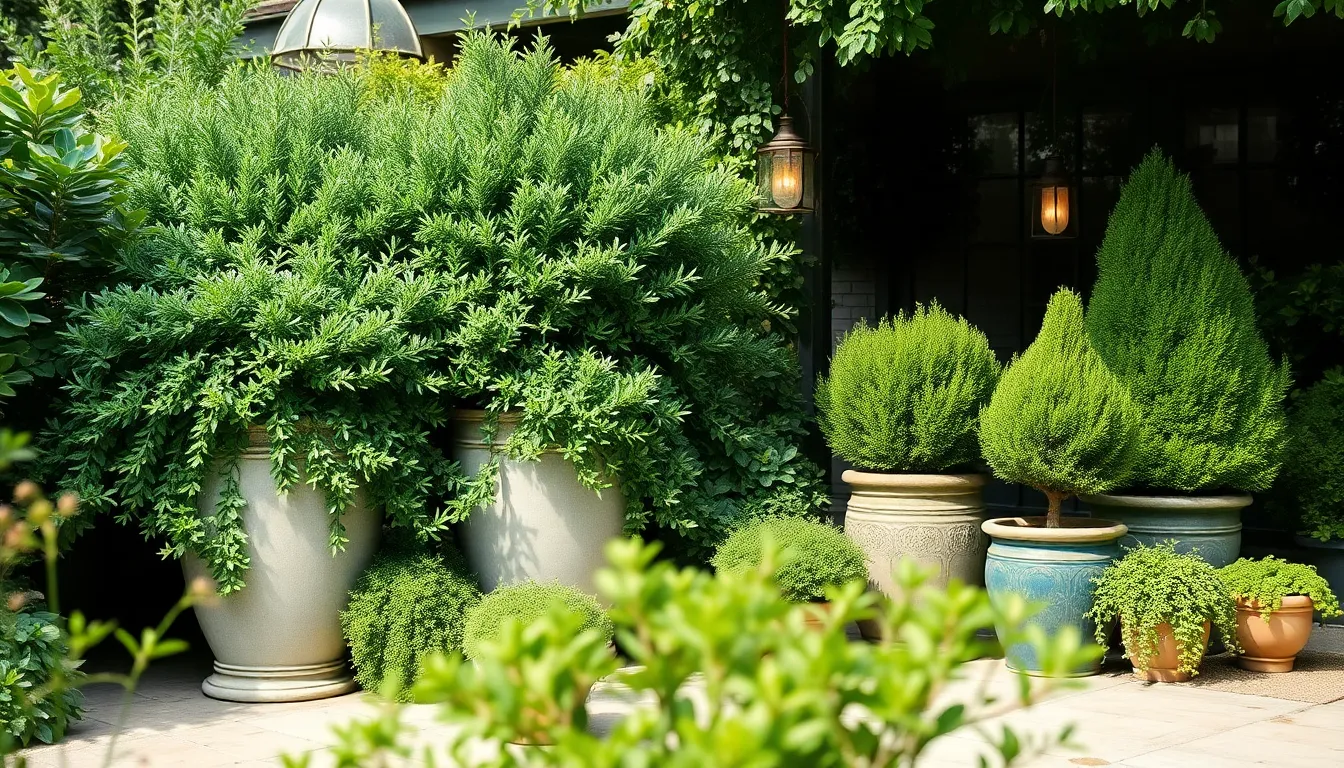
Yews stand out as exceptional evergreen choices for shaded container gardens because they tolerate low light conditions and harsh winter climates better than most alternatives. We recommend selecting cultivars that are hardy at least one zone colder than your location since potted plants face more root exposure to freezing temperatures.
Spreading Yew Cultivars
Spreading yews create beautiful groundcover effects in containers where you want trailing or cascading greenery. These cultivars grow wider rather than upright, making them perfect for large decorative pots or elevated planters where their form can spill gracefully over the edges. Dense foliage provides year round coverage in shaded spots that many other evergreens struggle to fill.
Popular spreading types maintain their compact form well within container constraints. We’ve found these varieties adapt remarkably to pot restrictions while still requiring adequate root space for healthy development. Their slow growth pattern means less frequent repotting compared to faster growing alternatives.
Container grown spreading yews add instant structure to shaded patios and balconies. Winter hardiness makes them reliable choices for year round outdoor displays when properly protected during extreme cold spells. These cultivars work exceptionally well in mixed container arrangements where you need evergreen foundation plants.
Compact Upright Yew Types
Compact upright yews bring vertical interest to container gardens without quickly outgrowing their allocated space. Their naturally tidy growth habit eliminates the need for frequent pruning while maintaining formal appearance in decorative pots. We particularly value these varieties for their ability to create height variation in container groupings.
These upright cultivars thrive in the limited root space that containers provide. Slow growth rates match perfectly with pot culture requirements, allowing plants to remain healthy for years without becoming rootbound. Their cold hardiness translates well to winter container conditions when pots receive proper insulation.
Formal container arrangements benefit greatly from the structural elements these yews provide. Year round greenery anchors seasonal displays while their narrow growth habit fits well on patios, balconies, and small outdoor spaces. Less maintenance compared to spreading types makes them ideal for busy gardeners who want reliable evergreen beauty.
Select Drought-Tolerant Lavender for Sunny Spots
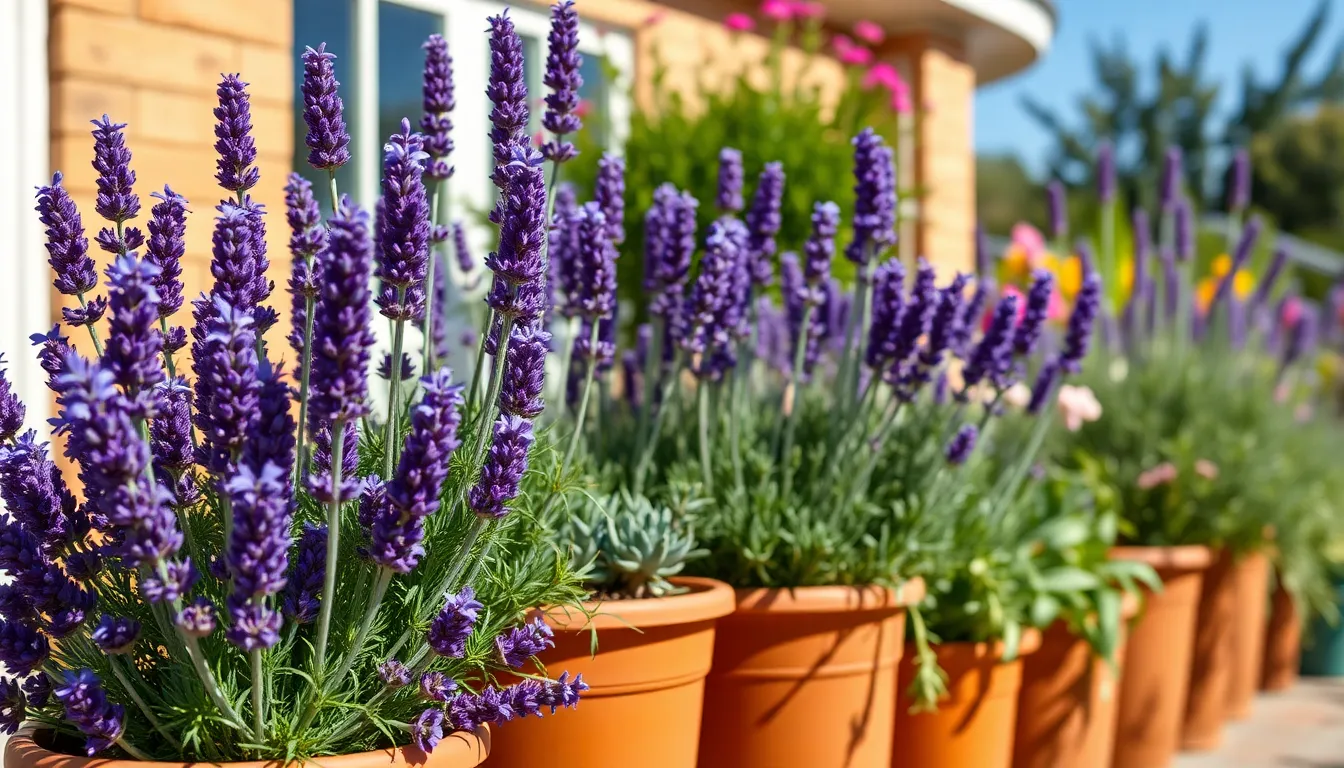
Lavender transforms sunny container gardens into fragrant sanctuaries while requiring minimal water and maintenance. These aromatic evergreens thrive in well-drained soil and full sun conditions, making them perfect companions for patios and balconies with excellent drainage.
English Lavender Varieties
English Lavender (Lavandula angustifolia) dominates container gardens with its compact form and classic purple flower spikes. We recommend this variety for its exceptional cold hardiness and reliable blooming performance in pots. Its dense, silvery foliage creates beautiful contrast against darker evergreens like boxwood or yew.
Hidcote produces deep purple flowers on sturdy 18-inch stems, creating stunning focal points in large containers. This cultivar maintains its compact shape without frequent pruning, making it ideal for low-maintenance gardens.
Munstead offers earlier blooms and slightly smaller stature at 12-15 inches tall, perfect for smaller pots or mixed plantings. Its lavender-blue flowers complement other evergreens while providing continuous fragrance throughout the growing season.
Lady blooms reliably from seed in the first year, making it accessible for gardeners starting from scratch. This variety produces abundant flower spikes perfect for cutting and drying.
French Lavender Options
French Lavender varieties excel in heat tolerance and unique flower shapes, making them excellent choices for sunny, warm locations. These Mediterranean natives adapt well to container restrictions while providing extended blooming periods.
Lavandula dentata features distinctive serrated leaves and continuous blooming throughout warm weather. We’ve found this variety particularly successful in large containers where its spreading habit can develop fully.
Lavandula stoechas cultivars produce butterfly-like bracts atop their flower spikes, creating architectural interest in container displays. Popular varieties like ‘Otto Quast’ and ‘Ballerina’ offer different bloom colors from deep purple to soft pink.
Spanish Lavender (Lavandula stoechas pedunculata) develops exceptionally long flower bracts that dance in gentle breezes. This variety works beautifully in modern container designs where its sculptural qualities shine.
Regular pruning after flowering encourages dense, bushy growth and prevents these lavenders from becoming woody. We recommend harvesting stems regularly for indoor use, which naturally promotes continued blooming and maintains attractive container shapes.
Plant Versatile Holly for Berry Production
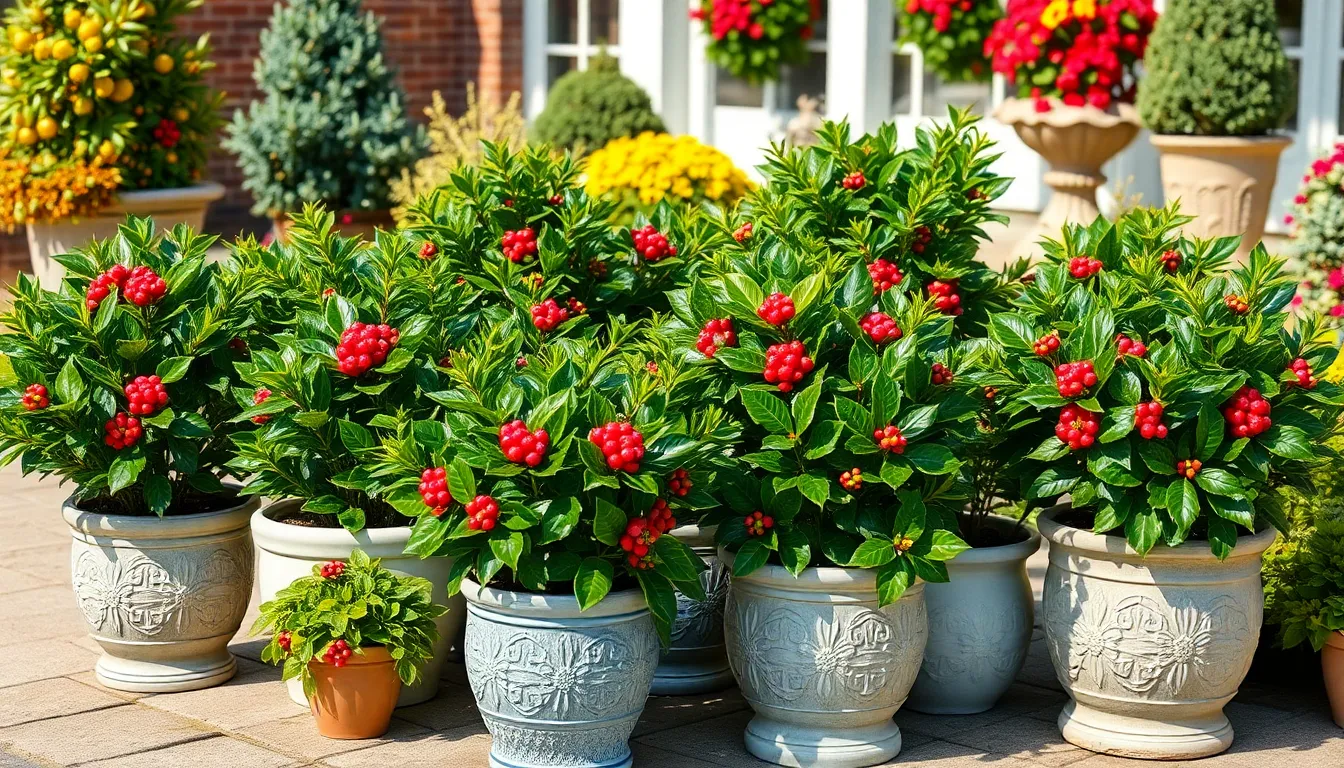
Moving beyond drought-tolerant options, we’ll explore holly plants that offer stunning berry displays while maintaining evergreen appeal in containers. These remarkable shrubs provide both male and female plants needed for successful berry production, creating vibrant winter interest that attracts birds to your outdoor space.
Compact Holly Varieties
Sky Pencil holly (Ilex crenata ‘Sky Pencil’) transforms narrow spaces with its tall, columnar growth habit that rarely exceeds 3 feet wide. This Japanese holly cultivar reaches 6-8 feet tall while maintaining its slender profile, making it perfect for flanking doorways or creating vertical accents in container arrangements. We recommend this variety for minimalist garden designs where space is at a premium.
Blue Prince and Blue Princess hollies deliver exceptional performance as a matched pair for berry production. Blue Princess produces abundant red berries when pollinated by Blue Prince, and both varieties maintain dense, compact forms under 4 feet tall. Their blue-green foliage provides year-round color that complements other container plants beautifully.
Nellie Stevens holly combines vigorous growth with reliable berry production in container culture. This hybrid variety reaches 6-8 feet in pots and produces heavy clusters of bright red berries without requiring a separate male pollinator. Its glossy dark green leaves create an elegant backdrop for seasonal decorations.
Dwarf Japanese Holly Types
Compacta Japanese holly (Ilex crenata ‘Compacta’) offers boxwood-like appearance with superior pest resistance. This cultivar grows slowly to 3-4 feet tall and wide, featuring small, dense leaves that respond well to shaping and pruning. We find this variety particularly valuable for formal container displays where consistent form matters most.
Helleri holly creates low, spreading mounds perfect for large decorative containers or mixed plantings. Growing only 2-3 feet tall but spreading 4-5 feet wide, this variety works exceptionally well in shallow, wide pots where it can cascade naturally. Its fine-textured foliage remains deep green throughout winter months.
Green Lustre Japanese holly provides glossy, dark green leaves that reflect light beautifully in shaded locations. This compact variety reaches 3-4 feet tall with a naturally rounded habit that requires minimal pruning. Its adaptability to various light conditions makes it ideal for containers that may be moved seasonally around your outdoor space.
Conclusion
We’ve shown you how evergreen plants can transform your container gardens into year-round showcases of natural beauty. From the structured elegance of boxwood to the aromatic appeal of lavender these plants offer endless possibilities for creating stunning displays that thrive in pots.
The key to success lies in matching the right plant to your exact conditions and space requirements. Whether you’re working with a sunny balcony or a shaded patio there’s an evergreen variety that’ll meet your needs while providing lasting visual impact.
Start with one or two varieties that appeal to you most and gradually expand your collection as you gain confidence. Your container garden will become a source of pride and enjoyment throughout every season.
Frequently Asked Questions
What are the main benefits of using evergreen plants in containers?
Evergreen plants in containers provide year-round beauty without constant replanting, making them perfect for low-maintenance gardening. They offer lasting structure and appeal to outdoor spaces like balconies and decks, transforming them into stunning retreats with minimal effort while maintaining visual interest through all seasons.
Which boxwood varieties are best for container gardening?
Dwarf boxwood varieties excel in containers, including Buxus sempervirens ‘Suffruticosa’ for formal displays, Green Gem boxwood for cold hardiness, Japanese boxwood for compact spaces, Winter Gem for harsh winters, and Green Mountain boxwood for rapid establishment and vertical interest in container arrangements.
What makes juniper plants ideal for container gardens?
Junipers offer dramatic needle-like texture and diverse growth habits with exceptional drought tolerance. Popular container varieties include Blue Star Juniper for silver-blue foliage, Green Mound for cascading effects, Aquavita for vertical interest, Gin Fizz for dense structure, and Tortuga for low mounding texture and urban resilience.
How can I use rosemary in ornamental container displays?
Rosemary combines culinary value with ornamental beauty. Prostrate varieties create stunning trailing displays in hanging baskets, while upright selections provide architectural structure. Regular harvesting encourages bushier growth in prostrate types, and upright varieties work well for formal herb gardens and topiary applications.
What are the best heather varieties for container growing?
Winter-blooming Erica species provide brilliant flowers during cold seasons and need acidic, well-drained soil. Summer-flowering Calluna species offer spectacular color while maintaining textured evergreen foliage. Both types require regular feeding with acid-loving plant fertilizers and root protection in colder climates.
Which conifers work well in container displays?
Dwarf Alberta Spruce creates elegant conical shapes with slow growth, perfect for long-term pot culture. Miniature pine varieties like Dwarf Mugo Pine offer diverse textures and colors. These compact cultivars require well-draining soil and light fertilization while providing excellent focal points for container gardens.
What broadleaf evergreens are suitable for containers?
Compact rhododendrons and azaleas thrive in acidic soil and partial shade, providing lush foliage and vibrant spring blooms. Camellias offer elegant dark green leaves and winter flowers. Both require consistent moisture, acidic soil, and are perfect for smaller spaces while ensuring year-round visual appeal.
Are yews good choices for shaded container gardens?
Yes, yews are exceptional for shaded containers due to their low light tolerance and winter hardiness. Choose cultivars hardy one zone colder than your climate. Spreading varieties create groundcover effects, while compact upright types provide vertical interest without outgrowing their space quickly.
How do I care for lavender in containers?
Lavender thrives in sunny containers with minimal water and maintenance. English Lavender varieties like Hidcote and Munstead offer cold hardiness and compact forms. French Lavender excels in heat with unique flowers. Regular pruning maintains bushy growth, and well-draining soil prevents root rot.
Which holly varieties produce the best berry displays in containers?
Sky Pencil holly works perfectly for narrow spaces, while Blue Prince and Blue Princess hollies pair for successful berry production. Nellie Stevens holly produces reliable berries without male pollinators. Dwarf Japanese holly varieties like Compacta and Helleri offer formal displays and cascading effects respectively.

